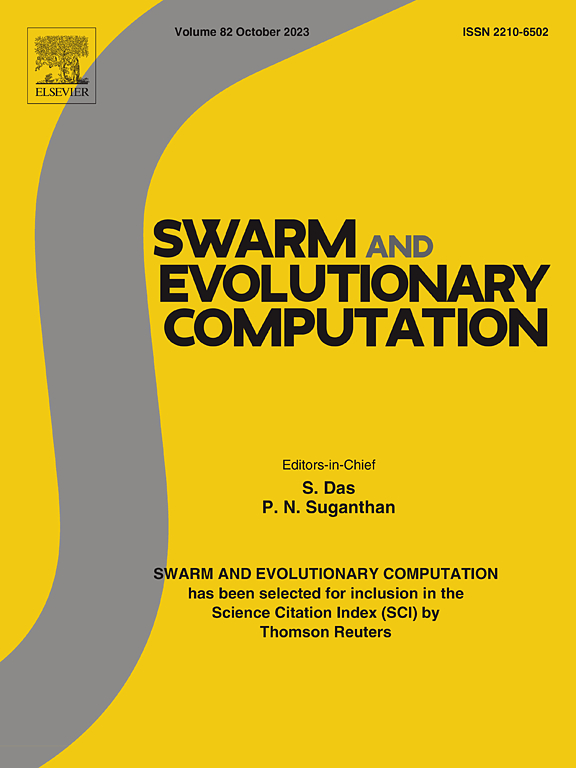Performance evaluation for accelerated and efficient prediction of different regression models aggravated with BPSO for enhancing area efficiency through state encoding in sequential circuits
IF 8.2
1区 计算机科学
Q1 COMPUTER SCIENCE, ARTIFICIAL INTELLIGENCE
引用次数: 0
Abstract
Minimizing circuit size and cost is a critical challenge in digital design, particularly in Finite State Machine (FSM) synthesis, which is essential for sequential systems. FSMs, implemented as Mealy or Moore machines, play a vital role in embedded systems and communication protocols. However, optimizing FSMs is inherently complex due to the NP-hard State Assignment Problem (SAP), which impacts circuit area, performance, and power efficiency. Traditional methods like KISS and NOVA often struggle with scalability and efficiency, highlighting the need for advanced solutions. To address this, we propose a Binary Particle Swarm Optimization (BPSO) approach integrated with regression-based predictive models, including Linear Regression (LR), K-Nearest Neighbor Regression (KNN), and Support Vector Regression (SVR). By leveraging a dataset of particle populations and their fitness evaluations, the predictive framework replaces computationally intensive cost simulators like ESPRESSO/SIS, significantly reducing runtime while maintaining high accuracy. Experimental results demonstrate that the BPSO-based approach achieves significant area cost reductions, with a 4.9% improvement in two-level optimization and 5.62% in multi-level optimization. The predictive model significantly improves computational efficiency, reducing total run-time by to , with the highest speedup observed in planet () and the lowest in dk14 (). The model’s accuracy is validated by evaluating key performance metrics for different regression techniques. Support Vector Regression (SVR) achieves the highest prediction accuracy with an score of 0.987, outperforming KNN (0.986) and LR (0.973). SVR also exhibits the lowest Mean Absolute Percentage Error (MAPE) of 0.0627, followed by LR (0.081) and KNN (0.091). In terms of Mean Squared Error (MSE), KNN performs best with , followed by SVR () and LR (). Additionally, SVR demonstrates the lowest Mean Bias Deviation (MBD) of , signifying minimal systematic error, while KNN and LR yield and , respectively. Training times for the predictive model are significantly reduced, ranging from 0.2 to 2.4 min, with total execution times between 2.6 and 19.03 min, depending on the benchmark complexity. By integrating the predictive model, Support Vector Regression (SVR) consistently demonstrates the highest prediction accuracy, reaching up to 98.7%, making it particularly suitable for precision-critical applications. Additionally, SVR achieves an impressive R value of approximately 98.5%, while significantly reducing computational runtime. Graphical analyses reveal a strong correlation between predicted and actual values, validating the proposed model’s effectiveness. By integrating machine learning with heuristic optimization, the approach ensures a scalable and efficient solution for FSM area minimization, balancing accuracy with runtime efficiency. These findings highlight the potential of combining machine learning with metaheuristic algorithms to enhance FSM synthesis, improving performance while reducing computational costs.
在顺序电路中通过状态编码提高面积效率,利用BPSO对不同回归模型进行加速和有效预测的性能评价
最大限度地缩小电路尺寸和降低成本是数字设计中的一项重要挑战,尤其是对顺序系统至关重要的有限状态机(FSM)合成。以 Mealy 或 Moore 机器实现的 FSM 在嵌入式系统和通信协议中发挥着重要作用。然而,由于状态分配问题(SAP)具有 NP 难度,优化 FSM 本身就很复杂,会影响电路面积、性能和能效。KISS 和 NOVA 等传统方法往往在可扩展性和效率方面存在问题,因此需要先进的解决方案。为解决这一问题,我们提出了一种二元粒子群优化(BPSO)方法,该方法与基于回归的预测模型(包括线性回归(LR)、K-近邻回归(KNN)和支持向量回归(SVR))相结合。通过利用粒子群数据集及其适配性评估,该预测框架取代了计算密集型成本模拟器(如 ESPRESSO/SIS),在保持高精度的同时显著缩短了运行时间。实验结果表明,基于 BPSO 的方法显著降低了面积成本,在两级优化中提高了 4.9%,在多级优化中提高了 5.62%。预测模型大大提高了计算效率,将总运行时间缩短了 1.2 倍至 1.89 倍,其中 planet(1.89 倍)的运行速度最高,dk14(0.85 倍)的运行速度最低。通过评估不同回归技术的关键性能指标,验证了模型的准确性。支持向量回归(SVR)的预测准确率最高,R2 得分为 0.987,优于 KNN(0.986)和 LR(0.973)。SVR 的平均绝对百分比误差 (MAPE) 也最低,为 0.0627,其次是 LR(0.081)和 KNN(0.091)。在平均平方误差 (MSE) 方面,KNN 的表现最好,为 3.85×10-6,其次是 SVR(3.92×10-6)和 LR(3.96×10-6)。此外,SVR 的平均偏差(MBD)最低,为 3.62×10-6,表明系统误差最小,而 KNN 和 LR 的误差分别为 3.34×10-5 和 2.4×10-5。预测模型的训练时间大幅缩短,从 0.2 分钟到 2.4 分钟不等,总执行时间在 2.6 分钟到 19.03 分钟之间,具体取决于基准的复杂度。通过集成预测模型,支持向量回归(SVR)始终保持着最高的预测准确率,最高可达 98.7%,因此特别适用于对精度要求极高的应用。此外,SVR 的 R2 值达到了令人印象深刻的约 98.5%,同时大大减少了计算运行时间。图形分析表明,预测值和实际值之间具有很强的相关性,验证了所提出模型的有效性。通过将机器学习与启发式优化相结合,该方法可确保为 FSM 面积最小化提供可扩展的高效解决方案,同时兼顾准确性与运行时间效率。这些发现凸显了将机器学习与元启发式算法相结合来增强 FSM 合成的潜力,在提高性能的同时降低了计算成本。
本文章由计算机程序翻译,如有差异,请以英文原文为准。
求助全文
约1分钟内获得全文
求助全文
来源期刊

Swarm and Evolutionary Computation
COMPUTER SCIENCE, ARTIFICIAL INTELLIGENCEC-COMPUTER SCIENCE, THEORY & METHODS
CiteScore
16.00
自引率
12.00%
发文量
169
期刊介绍:
Swarm and Evolutionary Computation is a pioneering peer-reviewed journal focused on the latest research and advancements in nature-inspired intelligent computation using swarm and evolutionary algorithms. It covers theoretical, experimental, and practical aspects of these paradigms and their hybrids, promoting interdisciplinary research. The journal prioritizes the publication of high-quality, original articles that push the boundaries of evolutionary computation and swarm intelligence. Additionally, it welcomes survey papers on current topics and novel applications. Topics of interest include but are not limited to: Genetic Algorithms, and Genetic Programming, Evolution Strategies, and Evolutionary Programming, Differential Evolution, Artificial Immune Systems, Particle Swarms, Ant Colony, Bacterial Foraging, Artificial Bees, Fireflies Algorithm, Harmony Search, Artificial Life, Digital Organisms, Estimation of Distribution Algorithms, Stochastic Diffusion Search, Quantum Computing, Nano Computing, Membrane Computing, Human-centric Computing, Hybridization of Algorithms, Memetic Computing, Autonomic Computing, Self-organizing systems, Combinatorial, Discrete, Binary, Constrained, Multi-objective, Multi-modal, Dynamic, and Large-scale Optimization.
 求助内容:
求助内容: 应助结果提醒方式:
应助结果提醒方式:


